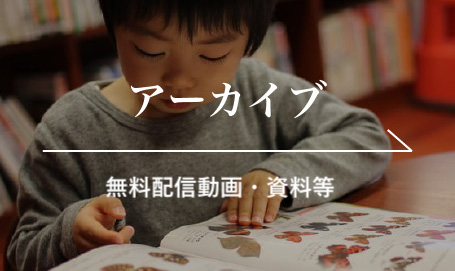Author(s): Nakanishi Sayaka.
Title: A Study of Children’s ‘Learning’in Early Childhood Care and Education : Focusing on Schafer’s Perspective on Bildung as Self-Formation.
Research on Early Childhood Care and Education in Japan, 2013, 51(2), 154-162.
Abstract: The purpose of this study is to examine discussion on the concept of Bildung in Germany for creating viewpoint of children’s ‘learning’ in early childhood care and education. I especially examine the concept of Bildung as ‘self-formation discussed by Schafer, G.E. His Bildung theory suggests the following points for children’s learning’ in early childhood care and education: (1) Children’s thinking and inner activities are regarded as starting points of ‘learning’. (2) Children’s senses, feelings, imagination and fantasy are placed as ‘the way of understanding the world’.
Keywords: learning, German ECEC, Bildung, self-formation, Schӓfer
—————–
Author(s): Sagawa Sakiko.
Title: An Analysis of How Motifs Are Produced in Children’s Collaborative Creative Play : Focusing on Children’s Gaze Direction.
Research on Early Childhood Care and Education in Japan, 2013, 51(2), 163-175.
Abstract: This study aims to clarify how motifs are produced in children’s collaborative creative play. Participatory observation was conducted in two kindergarten classes of 4-year-olds and 5-year-olds, respectively, for 6 months. Both verbal and non-verbal interactions among children were analyzed. The analysis of the children’s gaze direction revealed that they obtained information about the creative process by observing their playmate’s creations, and that before producing their own motifs they diverted their attention for a moment from the mutual creative play. This suggests that diversion of attention is a necessary part of the process by which children make their own motifs derived from others’ ideas. The analysis also showed that the reciprocal verbalization of motifs operated to bring novelty to the children’s creative play, so that it developed in a collaborative and improvisational way.
Keywords: creative play, motifs, gaze direction, micro-genetic analysis, 4- and 5-year-olds
—————–
Author(s): Kaneko Yoshihide, Sakai Aiichiro, Nanakida Atsushi.
Title: A Study of How Infants Create and Change Playing Rules of A Playground Equipment.
Research on Early Childhood Care and Education in Japan, 2013, 51(2), 176-186.
Abstract: Though several researches already focused on playground equipments, such as slides, and swings, they thought highly of how teachers treated the environment, and didn’t take how the infants perceive the playground equipment and create the rules into account well. In this thesis, however, by focusing on the “tire-swing”, a unique equipment placed on the playground of the “A” Kindergarten, the rules created and changed by infants were carefully detected. As a result, the following two points were found. At first, the infants interpret the intrinsic conditions of the “tire-swing” into their playing rules. Secondly, dynamic changes of playing rules were fostered by the atmosphere which allows “trial and error”, “frank conversations”, and “coexistence of rules”.
Keywords: kindergarten, playground equipment, playing rules, interaction
—————–
Author(s): Matsubara Miki, Motoyama Masako.
Title: Collaborative Resolution of Interpersonal Conflicts Occurred by 4-Year-Old Toddlers in the Kindergarten : How Toddlers Intervened in Others’Conflicts as Persons No Concerned?.
Research on Early Childhood Care and Education in Japan, 2013, 51(2), 187-198.
Abstract: This study aims to explore toddlers’ interventions to interpersonal-conflict situations. 4-year-old toddlers were observed in free-play situations and snack time. Results indicated that toddlers gazed conflicts in the case where their teacher solved them. This was the action which showed the awareness of conflicts. In the case where toddlers and their teacher intervened in conflicts, toddlers explained the situation to their teacher or warned the toddler concerned. In the case where only toddlers intervened, more toddlers showed one-sided support than mediation. One-sided Support was an unfair intervention, so it was difficult for toddlers who showed this intervention to solve conflicts. In contrast, mediation was a fair and effective intervention. Some toddlers could mediate conflicts. These toddlers had a great influence because some toddlers modeled after their interventions.
Keywords: interpersonal-conflict, intervention, 4-year-olds, the toddler no concerned
—————–
Author(s): Kiso Yoko.
Title: The Relationship between the Number of Children with Suspected Developmental Disorders and Burnout in Nursery School Teachers : A Cross-Sectional Postal Survey.
Research on Early Childhood Care and Education in Japan, 2013, 51(2), 199-210.
Abstract: This study examines how burnout in nursery school teachers is associated with the number of children with suspected developmental disorders and the level of teachers’ knowledge of developmental disorders. A cross-sectional design was employed whereby questionnaires were posted to teachers of 84 nursery schools. The data from 607 teachers were finally used in the analysis. Multiple-regression analysis showed significant relationships between the teachers’ burnout scores and the number of children with suspected developmental disorders, the knowledge level and the number of teachers in class, but no association between teachers’ burnout scores and the number of children diagnosed with disorders. The findings suggest that teachers face particular difficulties in caring for children with suspected developmental disorders. Improving teachers’ knowledge of developmental disorders and the understaffing problem may contribute to preventing teachers’ burnout.
Keywords: children with suspected developmental disorders, nursery school teachers, burnout, knowledge of developmental disorders, quantitative research
—————–
Author(s): Ito Yu.
Title: The Feature of a Childcare Teacher’s Approach at Lunchtime in a Nursery School.
Research on Early Childhood Care and Education in Japan, 2013, 51(2), 211-222.
Abstract: The aim of this study is to examine the approach of childcare teachers, and clarify the features of their approach at lunch time in nursery schools. As a result, the situation did not show an ideal approach even though they tried to work on children intentionally at lunchtime. I found two features of their approach which caused the problem: (1) There might be the danger that childcare teachers work on children in the way that goes against their physical and instinctive wishes, and giving them psychological burden. (2) There is the difficulty that childcare teachers have to consider their action so that they can make children eat lunch, enjoy the lunchtime, and learn eating habits at the same time, though these actions are incompatible.
Keywords: lunchtime, childcare teacher, a nursery school, features of approach
—————–
Author(s): Matsunaga Aiko, Ohiwa Michino, Kishimoto Miki, Yamada Yuri.
Title: The Kindergarten Teacher’s Role to Raise the Normative Consciousness of the Group of 3 Years Old Children : An Analysis by Focused on Nonverbal-Response Relation.
Research on Early Childhood Care and Education in Japan, 2013, 51(2), 223-234.
Abstract: The purpose of this paper is to clarify the role of the kindergarten teachers nonverbal-communication among the group of children in the process of the “cultivating a normal consciousness”. For this purpose, the study team carried out a case study by continuously observing the practice of child education. As a result, we found two things. First, “physical synchronicities” spreads among the group of children after six stages. At the last stage, “physical synchronicities” becomes “Nori (rhythm rules)” that rules the children’s action. It also generates the “intimate sphere” where every child comes to accept each other. In the “intimate sphere”, they take the normative action voluntarily. Second, the teacher’s attitude to look at the bright side of the children’s action is necessary to generate the “intimate sphere”.
Keywords: the group of child, nonverbal response relationship, normal consciousness, the intimate sphere, care study
—————–
Author(s): Nagase Yumiko, Kuramochi Kiyomi.
Title: Caregivers’ Intervention at the Clean-Up Scene in the Kindergarten.
Research on Early Childhood Care and Education in Japan, 2013, 51(2), 235-244.
Abstract: The purpose of this study is to focus on the clean-up scene in the kindergarten and clarify how the caregiver intervenes in a variety of preschooler’s own situations. Subjects were 28 preschoolers belonging to 3 years class, 26 preschoolers belonging to 5 years class and a class caregiver. 3 years class’s caregiver intervened more often in preschoolers who didn’t clean up than 5 years class’s caregiver. She communicated with preschoolers about the activity before clean up time, and as a result preschoolers could stop to play the activity and start to clean up. 5 years class’s caregiver intervened more often in preschoolers who were cleaning up. She taught preschoolers how to clean up. These results showed that the caregiver intervened flexibility depending on preschooler’s age and situation.
Keywords: clean-up scene, caregiver’s intervention, kindergarten, 3-year-olds, 5-year-olds
—————–
Author(s): Hayashi Masashi.
Title: How Do the After School Care Worker Try to Form Relationships among Children? : Analysis of the Narratives of After School Care Workers Using a Modified Grounded Theory Approach.
Research on Early Childhood Care and Education in Japan, 2013, 51(2), 245-256.
Abstract: The purpose of this study is to clarify how the after school care worker try to form relationship among children. The narratives of 15 after school care workers were obtained through interviews, and those were analyzed with modified grounded theory approach. As a result, those care workers tried to connect children through their play or activities in the daily processes of care. Also, they used their approval or recognition of children’s behaviors, sup- port for mutual understandings of children, and connection among parents/guardians as their means of building relationship among children. It was found that care workers utilized such actions repetitively and simultaneously so that children can relate to each other well. As effective, concrete suggestions for building relationships among children, the following 4 points were indicated: 1) to have intentions to approve and recognize achievements of children according to their capacity, 2) to lead children’s play and activities where children can gradually connect to, and 3) to give information to parents/guardians about children’s relationships in the after school care, and 4) to design changes of how much children interact in order to promote better relationships among children.
Keywords: after school care, after school care worker, relationship, narrative, modified grounded theory approach
—————–
Author(s): Tanaka Fumiaki, Toda Yuichi, Yokogawa Kazuaki.
Title: Understanding Communication Between Parents, Pre-Kindergarten Children and 5 Year-Olds During Peer Play Activity in Kindergarten : A Qualitative Analysis of Speech and Behavior of Parents Using M-GTA.
Research on Early Childhood Care and Education in Japan, 2013, 51(2), 257-269.
Abstract: The purpose of this study is to evaluate the effectiveness of a mixed aged kindergarten play activity by observing the behavior of its participants. Two groups of children; pre-kindergarten-aged children (PKC) and 5 year-old children (5YO) were each paired and guided to participate in an activity. Behavior and speech of both parents and paired groups were observed and recorded for analysis by M-GTA. A range of interactions between parents and 5YO were recorded which inferred much about parents’ emotional responses, commitment to participation and their understanding of child development. By examining the results chart it was possible to speculate on ways to improve the play activity and gain a better understanding of what characteristics are required to make a successful play program in the future.
Keywords: child rearing program, kindergarten, behavioral observation, M-GTA, mixed-age interaction
—————–









